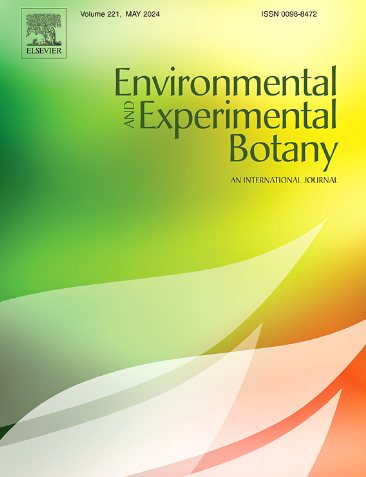不同时间涝渍对木耳生长和生理特性的影响
IF 4.5
2区 生物学
Q2 ENVIRONMENTAL SCIENCES
引用次数: 0
摘要
涝渍或土壤中水分的过度积累对河岸生态系统和农林业造成了重大压力,尤其是在全球降雨量增加的情况下。真菌是一种重要的农业资源、生物材料和具有高抗性和适应性的超级能源植物。本试验研究了在根系和地上涝渍条件下长达30 d的植株形态和生理反应。结果表明,涝渍显著抑制了植株生长,降低了膜透性,降低了根系活性,加速了叶片衰老(P <; 0.05)。尽管如此,C. fungigraminus在淹水30天后的存活率达到了100% %。植物通过皮质细胞松动、溶原组织形成和不定根发育来增强氧通道,以适应缺氧环境。它还激活了防御机制,增加了抗氧化酶(SOD, POD和CAT)的活性,非酶抗氧化剂(AsA和GSH),渗透调节剂(SS, SP和Pro),厌氧呼吸酶(PDC, ADH和LDH)和激素(ABA, IAA, GA和ETH)的水平。在两个涝渍深度水平下,植物最初采用Low-O2逃逸策略(LOES),但随着时间的推移,植物过渡到Low-O2静止策略(LOQS),同时仍保留了LOES的一些特征。结果表明,真菌菌对涝渍具有较强的适应性,尤其是对根系涝渍的响应。通过解剖调整和特殊的细胞防御机制,该物种有效地减轻了损害,使其成为涝渍条件下的优良护坡牧草。研究结果对选择耐涝品种,恢复和恢复黄河流域退化的河岸生态系统,优化涝渍易发区土地利用,推进其他牧草品种耐涝遗传改良具有重要指导意义。本文章由计算机程序翻译,如有差异,请以英文原文为准。
Effects of waterlogging at different duration on growth and physiological characteristics of Cenchrus fungigraminus
Waterlogging, or excessive accumulation of water in the soil, poses significant stress to riparian ecosystems and agroforestry, especially with increasing global rainfall. Cenchrus fungigraminus is a vital agricultural resource, biomaterial, and super-energy plant with high resistance and adaptability. This study examined its morphological and physiological responses under root and above-ground waterlogging for up to 30 days. Results showed that waterlogging significantly inhibited growth, reducing membrane permeability, and root activity, and accelerating leaf senescence (P < 0.05). Despite this, C. fungigraminus achieved 100 % survival after 30 days of waterlogging. The plant adapted to the hypoxic environment by enhancing oxygen channels through cortex cell loosening, lysigenous tissue formation, and adventitious root development. It also activated defense mechanisms, increasing the activities of antioxidant enzymes (SOD, POD, and CAT), levels of non-enzymatic antioxidants (AsA and GSH), osmotic regulators (SS, SP, and Pro), and anaerobic respiratory enzymes (PDC, ADH, and LDH), and hormones (ABA, IAA, GA, and ETH). Under two levels of waterlogging depth, the plant initially adopted the Low-O2 escape strategy (LOES), but over time, it transitioned to the Low-O2 quiescence strategy (LOQS), while still retaining some features of the LOES. Our results revealed that C. fungigraminus demonstrates strong adaptability to waterlogging, especially in response to root waterlogging. By employing anatomical adjustments and exceptional cellular defense mechanisms, the species effectively mitigates damage, establishing itself as an excellent forage grass for slope protection under waterlogged conditions. These results offer valuable guidance for selecting waterlogging-tolerant species to restore and rehabilitate degraded riparian ecosystems in the Yellow River Basin, optimize land use in waterlogging-prone areas, and advance the genetic improvement of waterlogging tolerance in other forage varieties.
求助全文
通过发布文献求助,成功后即可免费获取论文全文。
去求助
来源期刊

Environmental and Experimental Botany
环境科学-环境科学
CiteScore
9.30
自引率
5.30%
发文量
342
审稿时长
26 days
期刊介绍:
Environmental and Experimental Botany (EEB) publishes research papers on the physical, chemical, biological, molecular mechanisms and processes involved in the responses of plants to their environment.
In addition to research papers, the journal includes review articles. Submission is in agreement with the Editors-in-Chief.
The Journal also publishes special issues which are built by invited guest editors and are related to the main themes of EEB.
The areas covered by the Journal include:
(1) Responses of plants to heavy metals and pollutants
(2) Plant/water interactions (salinity, drought, flooding)
(3) Responses of plants to radiations ranging from UV-B to infrared
(4) Plant/atmosphere relations (ozone, CO2 , temperature)
(5) Global change impacts on plant ecophysiology
(6) Biotic interactions involving environmental factors.
 求助内容:
求助内容: 应助结果提醒方式:
应助结果提醒方式:


